GE2025: With a large number of multi-cornered fights on the cards, will this play into PAP's hands?
Early claims staked by opposition parties could result in multi-cornered fights in up to 15 constituencies. This number is expected to decline come Nomination Day, but several may be unavoidable due to coordination and strategic conflicts, analysts and party insiders say.
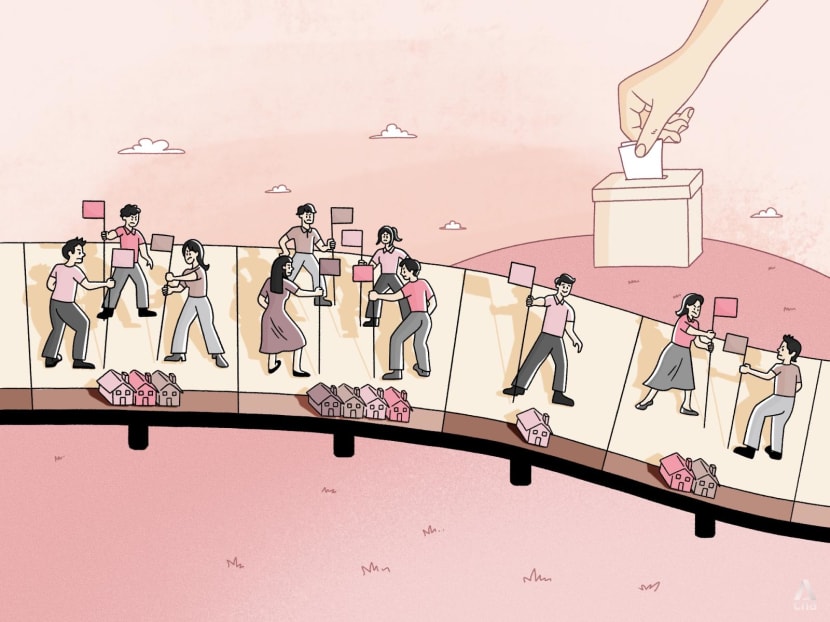
The growing number of political parties and the finite number of seats up for grabs make multi-corner fights more likely during the upcoming General Election in 2025. (Illustration: CNA/Nurjannah Suhaimi)

This audio is generated by an AI tool.
From the moment that Singapore's redrawn electoral boundaries were revealed on March 11, opposition political parties moved quickly to draw up their game plans.
Barely a month on, flag poles have been (metaphorically) planted across the land. In some districts, various opposition parties are still wrangling over who should contest.
A total of 97 seats in 33 constituencies are up for grabs at the upcoming General Election (GE).
Based on media reports on party movements and statements of intent made by parties themselves, as of April 11, as many as 13 of these – eight Group Representation Constituencies (GRCs) and five Single Member Constituencies (SMCs) – could see a three-cornered fight in the upcoming election.
Two more, Jalan Kayu SMC and Tampines GRC, might even see a four-party face-off.
If such a scenario – excluding independent candidates – fully comes to pass, GE2025 will be one of Singapore's most keenly contested polls ever.
However, things could look different by Nomination Day, because political analysts believe that some of the opposition parties staking claims to these popular sites will likely back down.
Looking at historical data, Dr Elvin Ong from the department of political science at the National University of Singapore (NUS) said that 95 per cent of all potential multi-cornered contests resolve into head-to-head races before Nomination Day.
Indeed, in just the last few weeks, some opposition parties have already publicly backed out of certain areas that they had initially said they would contest, while bilateral talks between parties are reportedly ongoing.
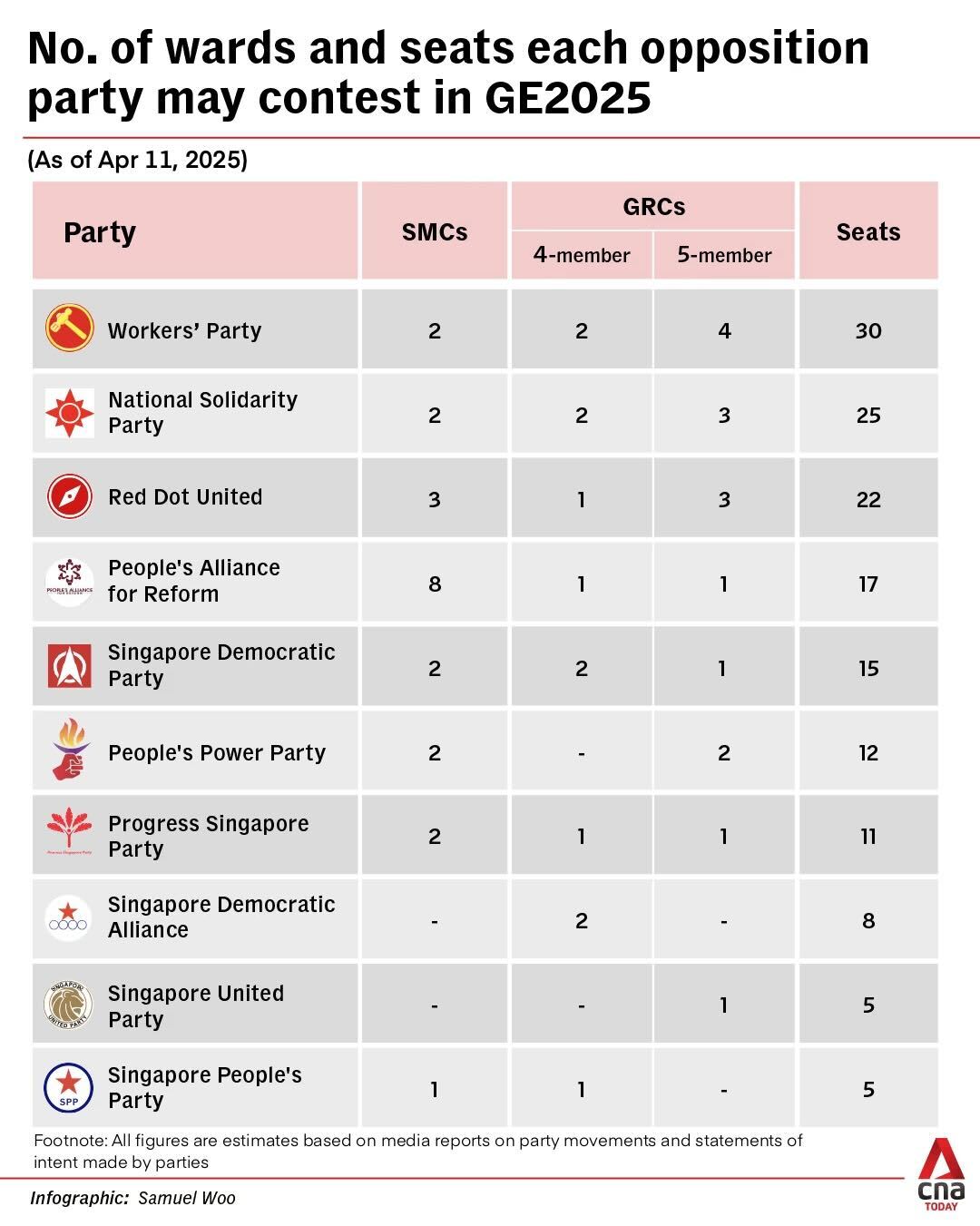
There were political observers, including associate professor and former nominated member of parliament Eugene Tan, who noted that there is a higher-than-usual number of constituencies with multiple claims this time round, as compared with the lead-up to past elections.
Mr Jose Raymond, former chair of Singapore People’s Party (SPP), likewise noted that in 2020 when he contested in Potong Pasir SMC, there were not this many potential multi-cornered fights even before Nomination Day.
In the past seven elections since 1991, there have been only 14 multi-cornered fights altogether.
The previous one in 2020 saw a GRC being contested by more than two parties for the first time, when Pasir Ris-Punggol was fought over by the People's Action Party (PAP), Singapore Democratic Alliance (SDA) and Peoples Voice.
The only other multi-cornered GRC contest in Singapore's political history took place almost three decades before, in a 1992 by-election for Marine Parade.
Teams from the Singapore Democratic Party (SDP), National Solidarity Party (NSP) and the Singapore Justice Party were defeated resoundingly by the PAP slate led by then-Prime Minister Goh Chok Tong.
Multi-way fights in SMCs are more common.
In 2020, Pioneer SMC was fought over by Mr Patrick Tay from PAP, Mr Lim Cher Hong from Progress Singapore Party (PSP) and independent candidate Cheang Peng Wah.
In GE2015, three SMCs had multi-cornered fights, two of them involving independent candidates.
And in GE2011, there was a three-horse race in one SMC.
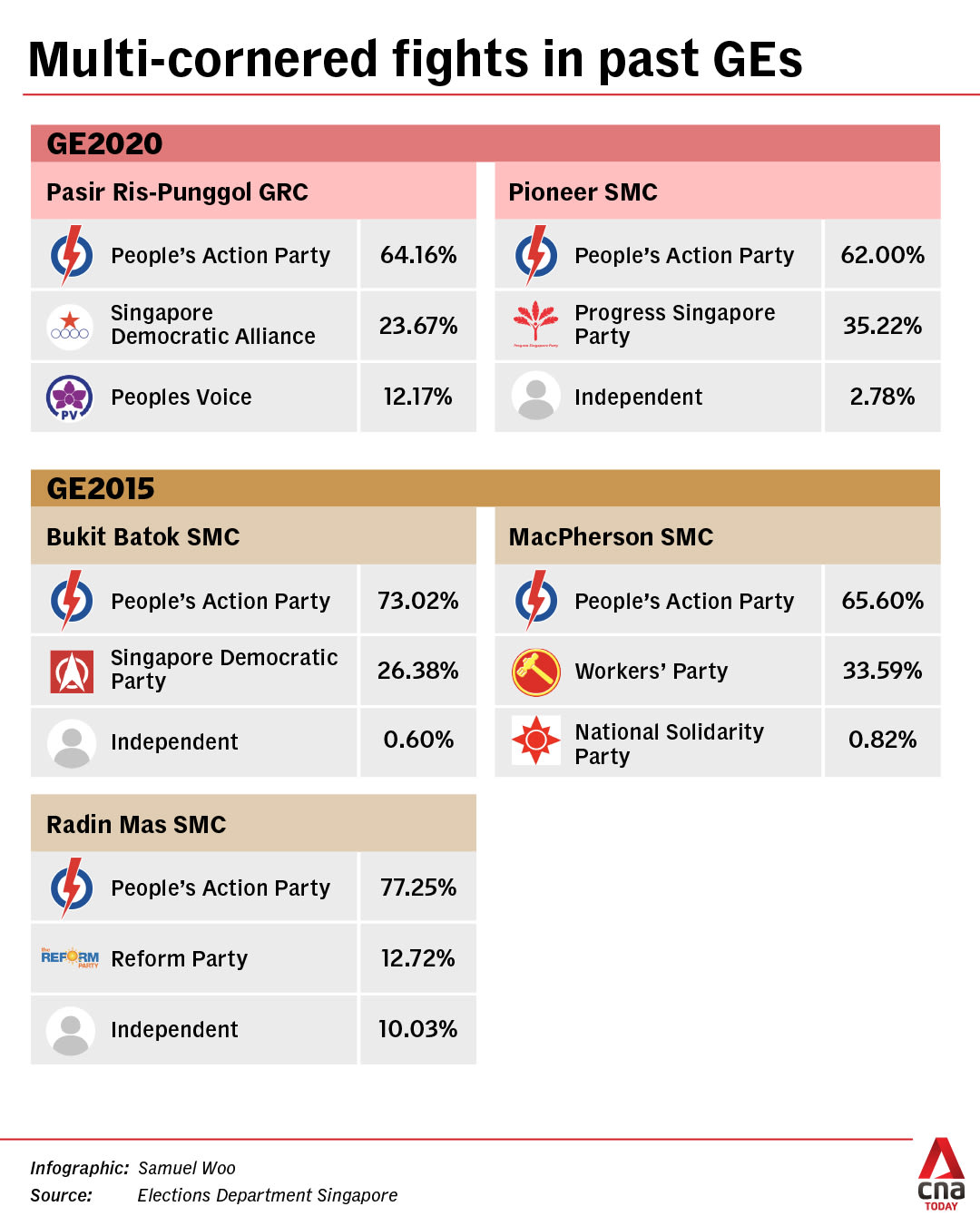

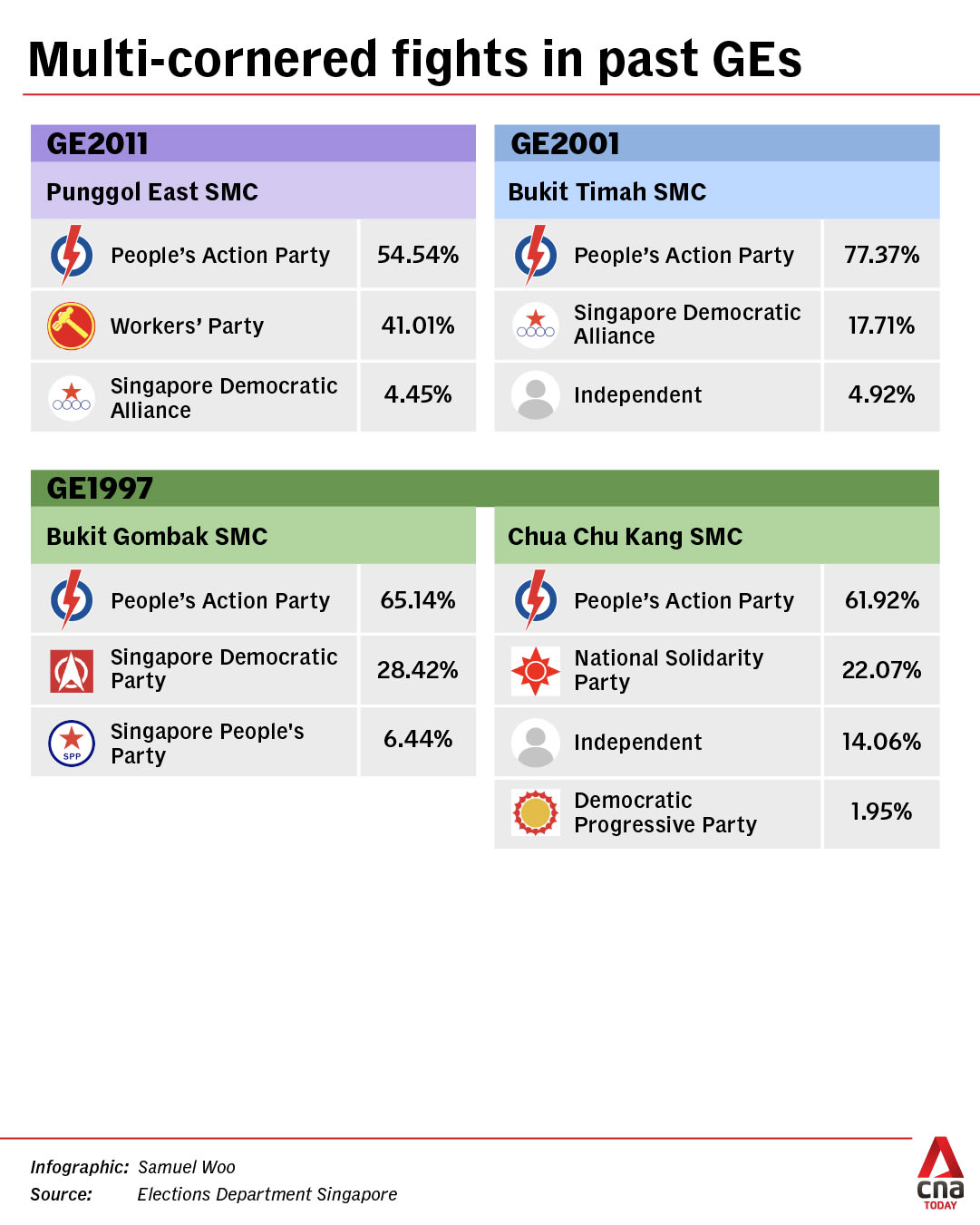
Analysts said that in such fights, the ruling party tends to benefit because the opposition vote would be diluted.
It is for this reason that opposition parties traditionally come together for “horse-trading talks” to decide which parties would compete in which constituencies and avoid multi-cornered fights.
Now, party sources who have attended these talks over the years told CNA TODAY that such meetings are no longer as productive as they used to be. It is also unclear if such a meeting would help to resolve competing claims this year.
This is in part due to the emergence of new political parties, they said.
Another reason is that in recent years, some of the party leaders have taken a firmer stance about their strategies, either refusing to back down from their claims or refusing to take part in these negotiations.
Assoc Prof Tan from Singapore Management University (SMU) said that in light of the opposition political landscape becoming “more fragmented and more crowded than ever before”, multi-way contests “cannot be avoided”.
THE LAY OF THE LAND SO FAR
Since the last GE in 2020, one new formal political alliance, the People's Alliance for Reform (PAR), and one new political party, the Singapore United Party, have emerged and expressed their intent to contest in this year's election.
PAR – comprising Peoples Voice, the Reform Party (RP) and the Democratic Progressive Party – is led by lawyer Lim Tean,
The Singapore United Party is led by former RP chairman Andy Zhu.
Additionally, several of the older opposition parties have indicated that they want to contest more seats than they did in 2020.
This has inevitably contributed to greater overlapping claims of territory among the opposition.
Here is a closer look at the state of play as of April 11:
New alliance, expanded claims
Just over 20 minutes after the Electoral Boundaries Review Committee released its report last month, PAR announced its intent to contest 10 constituencies, comprising five adjacent SMCs in the north and a separate cluster of two GRCs and three SMCs in the south.
The constituencies where the alliance has staked a claim have a total of 18 seats – two more than the number of seats contested by its component parties in 2020.
Half of the identified potential multi-cornered fights involve constituencies claimed by PAR.
Mr Lim of PAR told CNA TODAY that the alliance has no intentions to horse-trade or cede to other parties.
"(Though) there may be one or two seats where we may be open to discussions ... we will want to see what candidates the other parties are putting up first," he said.
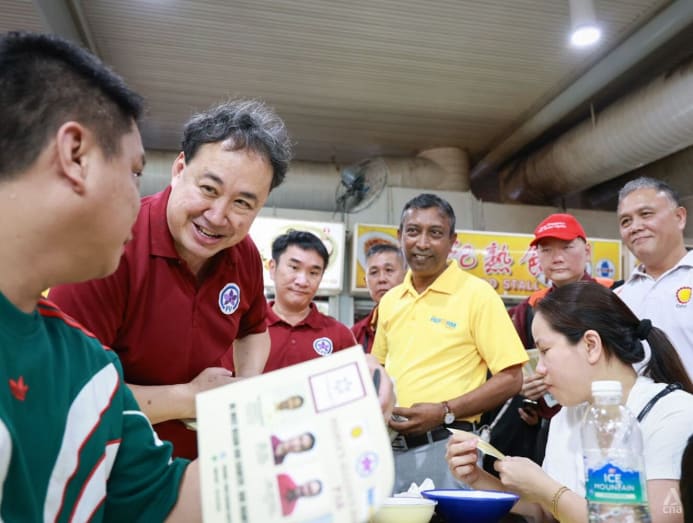
Red Dot United (RDU), which made its debut in 2020 by fielding a five-person team in Jurong GRC, initially expressed interest in six constituencies across Singapore.
Together, there are 18 seats across three five-person GRCs (Jurong East-Bukit Batok, Jurong Central and Tanjong Pagar) and three SMCs (Jurong Central, Jalan Kayu and Radin Mas).
On Thursday (Apr 10), RDU’s secretary-general Ravi Philemon announced that the party will also compete in Holland-Bukit Timah GRC if SDP decides not to do so.
At least half of the constituencies that the RDU is laying claim to this year are being eyed by other opposition parties as well.
Also expanding their claims this year are the People's Power Party (PPP) and NSP.
PPP’s secretary-general Goh Meng Seng was the party’s sole candidate in GE2020. This time, PPP has said that it would contest in Ang Mo Kio GRC and Tampines GRC.
It also said at first that it would fight in Nee Soon GRC, but the party has since withdrawn its claim there to make way for a showdown between RDU and PAP.
PPP is likely to face a three-cornered battle for Ang Mo Kio GRC after Mr Zhu from the Singapore United Party told the media on Thursday that his party was adamant about contesting there, too.
NSP contested in two GRCs in GE2020: Sembawang and Tampines.
This year, it is making more claims to SMCs newly carved out from the party’s old stomping grounds – Sembawang West and Tampines Changkat – as well as the more distant territories of Marine Parade-Braddell Heights GRC, Jalan Besar GRC and Marsiling-Yew Tee GRC.
Potential four-cornered fights
These claims have set the stage for a potential four-cornered fight in Tampines GRC, where NSP has consistently contested since the party’s inception in 1988.
At the same time, the Workers' Party (WP) has been focusing its efforts on the eastern region of the country and has been walking the grounds in Tampines over the past few years, political observers and other opposition party members noted.
WP has not made any formal announcements with regard to Tampines GRC, but one of its new faces, technology professional Andre Low, said in a live interview with political analyst and podcaster Walid Jumblatt on Tuesday (Apr 8) that “it is no secret” that he and his team have been walking the grounds in Tampines, adding that they have been doing so since January last year.
Another party to stake a claim in Tampines is PPP, which has announced its intent to contest there.
The newly formed single-seat ward Jalan Kayu, carved out of Ang Mo Kio GRC, may also see a four-way fight.
PPP, PAR and RDU expressed interest in the SMC soon after the new electoral boundaries were announced.
A few days later, labour chief and former Cabinet minister Ng Chee Meng was seen at a community event there with Senior Minister Lee Hsien Loong. When asked if he would be contesting there as PAP's candidate, Mr Ng said that all would be announced in due time, though he added that he has some familiarity with the area.
A team of roughly 20 volunteers and members from RDU was also seen walking the grounds almost a week after Mr Ng's visit, with the opposition party introducing Ms Kala Manickam as the member leading the party's work on the ground there.

Geographical concentration
While there has been a flurry of declarations of interest by the smaller opposition parties, the two opposition parties with parliamentary presence, WP and PSP, have carved out turfs that do not overlap with each other, political observers said.
WP contested West Coast GRC in GE1997 and Nee Soon GRC in GE2015. However, in GE2020, it focused its strategy on eastern and north-eastern Singapore and since then, it has been putting boots on the ground in these same areas.
Similarly, though PSP had contested in nine constituencies all across the island in 2020, its secretary-general Leong Mun Wai said last Sunday that it would likely field fewer candidates this year and only confirmed claims on West Coast-Jurong West GRC and Chua Chu Kang GRC.
SDP’s recently announced “northern strategy” is seen by political observers as trying to carve out a turf that largely prevents head-on collisions with PSP and WP.
Dr Mustafa Izzuddin, a senior analyst at business consultancy Solaris Strategies, said that SDP’s northern strategy may be similar to that of WP’s, where the party expands in areas “contiguous to their nerve centres”.
SDP told CNA TODAY that its strategy was adopted "partly for logistical reasons and also to leverage the advantages of having the cross-boundary support for the party".
Dr Teo Kay Key, a research fellow at the Institute of Policy Studies (IPS), said that the advantage goes beyond the consolidation of resources.
"Concentrating on one area means that there is a specific area in which the party can continue walking the ground, regardless of electoral boundaries," she added.
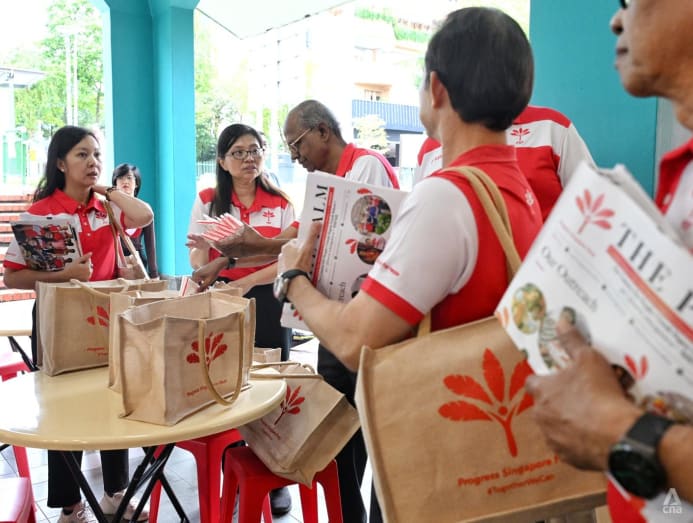
HOW CONSTITUENCIES ARE PICKED
Dr Ong of NUS said that there are several determining factors in the race to pick the right battlegrounds, but generally, these parties would want to claim constituencies to contest where they perceive they have the highest chances of winning.
SMCs are often seen as lower-hanging fruit, since both the required election deposit and the manpower resources needed to contest in these constituencies are significantly smaller, political observers said.
The latest redrawing of boundaries created six new SMCs, which makes for "new ground" that opposition parties likely feel they could break into, Dr Teo of IPS said.
One common rationale that parties give when deciding which constituencies to target is whether they have been working the ground in those areas.
For instance, Mr Zhu told CNA TODAY that the Singapore United Party chose Ang Mo Kio GRC as its battleground because the party's founding members had contested the GRC under the RP banner in 2020. Working on the same territory would also reinforce “ground visibility and allow residents to know them better”.
Both Mr Leong of PSP and Mr Ravi of RDU told CNA TODAY that in deciding where to contest, the parties consider their “familiarity” with the area, either in terms of whether they contested there in 2020 or if they have been engaging residents there.
Some parties draw on historical precedents.
For instance, in its move to stake a claim on Sembawang GRC, SDP referred to its past campaigns in the constituency in GE2006 and GE2011, despite not having contested there in the past two elections.
Now that several new parties have sprung up since 2015, opposition party insiders said that it has become harder for negotiations to be centred around past battle lines.
Instead, greater scrutiny is placed on the “quality” – a particularly subjective factor – of an opposition party’s slate of candidates.
Opposition sources said there tends to be a consensus among the opposition that if a party chief is chosen to contest in a constituency, other parties would step aside.
Then, there are parties that justify their picks based on symbolic or principled reasons.
Mr Goh the chief of PPP, for example, said last Saturday that the party wants to contest Ang Mo Kio GRC because its manifesto takes aim at the “mismanagement” of population policies for the past 20 years under Senior Minister Lee Hsien Loong, who helms the constituency.
Speaking to CNA TODAY on Wednesday, Mr Goh said that he would not back down from competing in either Ang Mo Kio GRC or Tampines GRC even if there is a multi-cornered fight in these areas.
He also said that he used to be involved in businesses in those towns and that he is still a recognisable face among its residents.
PPP would still contest those areas even if there is a chance of it garnering less than 12.5 per cent of votes: “Of course, we have a fear of losing our election deposit, but our mission is bigger than our fear."
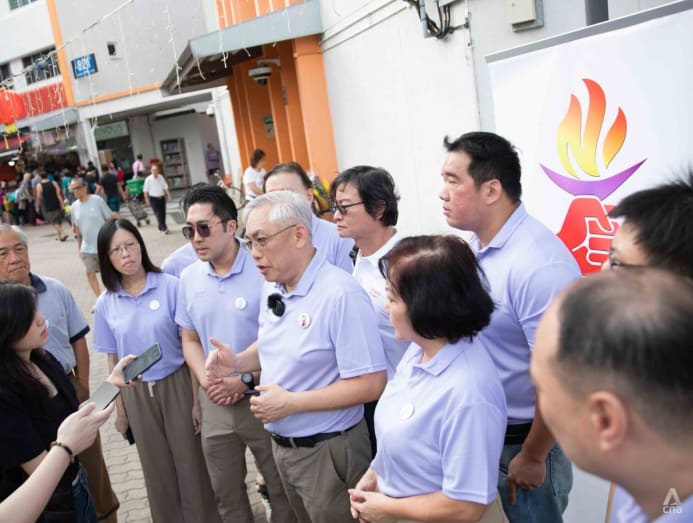
Separately, SDA's chairman Desmond Lim told CNA TODAY that he contested in Punggol East SMC’s three-way fight in 2011 alongside WP because he had hoped to “preserve the legacy” of the alliance’s former leader Chiam See Tong.
Experts and opposition leaders said that sometimes, opposition parties publicly stake claims on areas even when they do not plan to contest there eventually.
Dr Mustafa the senior analyst said that some parties might do this just to draw attention to themselves and their causes.
Some might also stake claims to more seats than they realistically have the resources to compete, using these extra constituencies as bargaining chips during the pre-polling powwows, some party insiders said.
FACTORS BEHIND GREATER CONTESTATION
The significant redrawing of electoral boundaries may have led to the higher-than-usual number of multi-cornered fights, experts said.
For instance, the newly formed Punggol GRC was carved out of the former Pasir Ris-Punggol GRC and Punggol West SMC, which SDA and WP respectively contested in GE2020.
Mr Lim from SDA said that the party is in contact with WP to decide who would run for Punggol, since both parties have consistently been working the ground there.
Similarly, SDP’s secretary-general Chee Soon Juan was set to contest Bukit Batok SMC, where he ran in 2020.
However, its absorption into the new Jurong East-Bukit Batok GRC led Dr Chee to announce his candidacy in Sembawang West SMC, where the boundaries include areas that used to be in Sembawang GRC – an area NSP had previously contested.
Dr Mustafa said there is still room for negotiations among opposition parties to avoid multi-way showdowns, even though the growing number of political parties and the finite number of seats up for grabs make multi-corner fights more likely this GE.
He agreed with other observers that some parties may be claiming stakes in areas where they do not have the resources to contest. It will only be clear closer to Nomination Day whether they have the required number of candidates to back up their claims.
"I think once the Writ of Election is issued, that's when you'll see the parties having more serious discussions with each other," Dr Mustafa added.
Another reason for the increased contestation appears to be a decline in coordination among opposition parties.
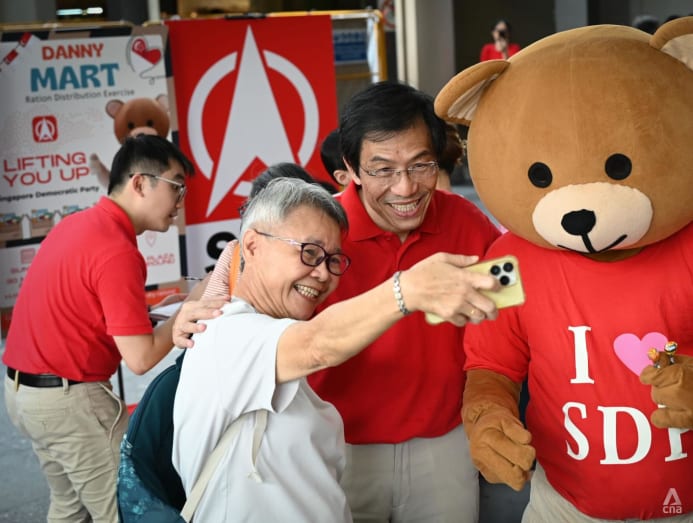
In GE1991, opposition MP Chiam See Tong devised a strategy for opposition parties that he dubbed the “by-election effect”: The opposition would contest fewer than half the parliamentary seats so that PAP would return to power immediately on Nomination Day.
Mr Chiam, who is 90 this year, is a long-time Potong Pasir MP who retired from politics in 2011. He is widely acknowledged as having successfully commanded respect from both sides of the political aisle.
Mr Chiam argued that voters would be more inclined to vote for the opposition if a PAP government was guaranteed. The strategy was generally credited for helping the opposition win four elected parliamentary seats that year.
Such coordinated tactics are increasingly difficult today when there are more opposition parties fighting over a limited number of seats.
Thus, a strategy to automatically concede half the seats to PAP would likely not fly, an opposition source said.
Furthermore, there is a lack of a figurehead in the opposition camp that has the ability to coordinate such strategies.
WP, widely regarded as Singapore's biggest and most credible opposition party, might seem like the likely choice to lead opposition coordination efforts.
Like Mr Chiam, former WP chief Low Thia Kiang has long been seen as a figurehead for the opposition camp. WP's current secretary-general Pritam Singh is the Leader of the Opposition, a title that was conferred on him after GE2020.
However, experts said that WP's size and reputation are precisely why the party does not see the need to “horse trade” with others.
Opposition sources told CNA TODAY that in the lead-up to GE2015, for example, a representative from WP attended a horse-trading meeting – but only to state where WP planned to contest.
The representative then left the meeting without taking part in the negotiations, the sources said.
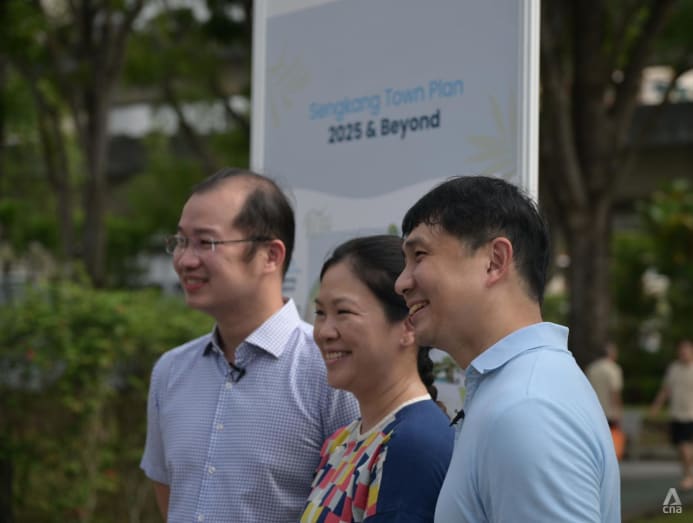
Some opposition party leaders told CNA TODAY that the horse-trading talks in the run-up to GE2015 were initiated by NSP.
With NSP yet to win any parliamentary seats despite taking part in every election since 1988, this hurts its credibility as the opposition's lead coordinator, one source who was at the 2015 meeting said.
The source also said that the same applies to other parties without parliamentary presence: “They do not carry the same kind of weight as someone like Chiam See Tong, especially when you already have an opposition party that has MPs in parliament. Who would give them face?”
He added that while not all opposition parties are “opposed” to each other, having differing values and views on Singapore’s future means that it is not easy for everyone to be on the same page.
“If the opposition can all come together, there would be no PAP today. But that is not possible,” he said.
SDP, however, sounded a more optimistic note.
It told CNA TODAY: "Discussions are generally cordial and realistic as we discuss the resources we have and what would be the best approach for Singaporeans."
It said that the very few multi-cornered fights in past elections point to the success of such discussions.
WHAT WOULD MULTI-CORNERED FIGHTS MEAN?
The conventional wisdom holds that multi-cornered fights inherently benefit PAP, since opposition votes would be split among various parties, thereby widening the ruling party’s margin of victory.
Indeed, in almost all past multi-cornered contests in general elections dating back to 1991, PAP came out on top comfortably, often garnering 60 per cent of the votes or more.
The slimmest margin recorded in such a contest was in the three-way tussle for Punggol East SMC in 2011, but even in this case, PAP’s Michael Palmer who was the winner received more than half (54.5 per cent) of the vote.
WP’s Lee Li Lian had about 41 per cent of the vote, while Mr Lim from SDA picked up around 4.5 per cent in the contest.

In essence, multi-cornered fights are disadvantageous for opposition parties hoping to win seats in parliament, though analysts believe that the number of multi-way contests will drop substantially by Nomination Day.
Still, this is not a given.
Dr Teo of IPS said: “There will be a need to go back to the negotiating table for parties that are inclined to do so, or for parties with limited resources to really determine where they should field their candidates.
“If the decision is not to negotiate and just make their own decisions, then we might see more multi-cornered fights, especially in SMCs.”
As Singapore's political scene continues to mature, will it see an increasing number of multi-cornered fights in future elections?
Experts and opposition leaders alike said that this might be inevitable, especially if new political parties continue to enter the fray.
And as existing opposition parties expand their ambitions, it would be tougher for new parties to avoid colliding with both the ruling party and older opposition parties.
Assoc Prof Tan of SMU said: "As WP gears up (to attain) its medium-term target of winning one-third of all elected seats, the smaller parties will find it harder to have enough constituencies where they have straight fights against PAP."
He added, though, that if GE2025 does see a higher-than-usual number of multi-corner fights and if this results in some parties losing their election deposits, that could put pause on the trend of multi-way contests in future elections.
As for the voters, even though some may prefer straight fights between the more established political parties, the analysts said that increased contestation in a general election is a sign that the nation is evolving into a more mature democracy.
Dr Teo said that the diversity of opposition provides a wider range of political choices for the electorate.
The overall results of the election would also provide a reflection of the types of political parties and political ideas that Singaporeans accept.
Giving another view, Assoc Prof Tan said that having options is good, but what voters want are "real choices".
"This means that parties have to differentiate themselves in meaningful ways through policy positions and candidate selections," he added.
"Ultimately, voters will 'vote pool' behind the (opposition) party they regard as being most able to take the fight to the ruling PAP."


















